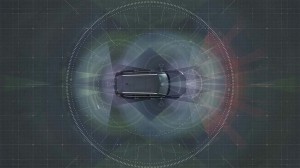
A variety of laser, radar, cameras and other sensors will give the pilot vehicles a 360-degree view.
Volvo plans to launch an autonomous vehicle pilot program by 2017, and it intends to use real motorists in its home town of Gothenberg, Sweden to get feedback on how well the technology works.
Dubbed Drive Me, the project is one of the more ambitious laid out by a conventional carmaker – though tech giant Google is already starting to roll out the first of 100 self-driving vehicles it plans to use as part of a test program near its Silicon Valley headquarters. Most major manufacturers are now working on autonomous technologies, with some predicting the first such vehicles could go on sale early in the next decade.
“We are entering uncharted territory in the field of autonomous driving,” said Peter Mertens, Senior Vice President Research and Development for the Volvo Car Group. “Taking the exciting step to a public pilot, with the ambition to enable ordinary people to sit behind the wheel in normal traffic on public roads, has never been done before.”
At first glance, the vehicles might be taken for any other conventional Volvo vehicle, but they will be equipped with a variety of sensors designed to detect weather and traffic, as well as spot pedestrians and other potential obstacles. These include:
- A combined radar and camera system mounted at the top of the windshield, similar to what will appear in the 2016 Volvo XC90 that goes on sale this coming spring;
- Four additional radar units placed at the corners of vehicles and which monitor what’s happening around the vehicle;
- Four more cameras that will also create a 30-degree view of what’s happening;
- A Multi-beam laser scanner in the front bumper that can look for cars, pedestrians and other obstacles nearly 500 feet ahead;
- Ultrasonic sensors around the vehicle to assist in parking and low-speed maneuvers;
- Two longer-range radar systems mounted in the rear bumper; and
- A trifocal camera system that compares different views of the road ahead to create a digital form of depth perception.
The 100 pilot vehicles also will be equipped with GPS navigation and be linked to a wireless vehicle-to-infrastructure network being set up in Gothenberg.
(New IIHS study suggests the era of zero highway deaths is a real possibility. Click Here to learn more.)
City officials will have the ability to disable the autonomous technology, say, when weather is bad, or if other problems occur. That would require motorists to take direct control. Indeed, that is an issue that researchers are focusing on closely, as one of the big questions is how long of a warning would a human co-pilot need to take over driving duties if a vehicle’s autonomous technology were to be disabled.
All of the Drive Me vehicles will still be equipped with a conventional steering wheel and pedals, allowing a motorist to take over. That’s a big difference from the Google Car pilot. Only some of the initial vehicles will have traditional controls. Later models are expected to have nothing more than an emergency shut-off button.
(Britain has launched four autonomous vehicle pilot programs. Click Here to learn more.)
Experts disagree over the pace at which autonomous vehicle technology will roll out. Google and Nissan are some of the more ambitious, the Japanese carmaker already promising to have a fully self-controlled product on the market by 2020.
By contrast, “We think it will take a little longer than some other companies do,” cautioned Steffen Linkenbach, the director of the North American autonomous vehicle research program run by Continental Teves, in an interview with TheDetroitBureau.com.
He anticipates that some semi-autonomous systems – such as Cadillac’s SuperDrive which will allow hands-off operation on limited-access roads — will be available by the beginning of the decade. But Linkenbach is among those proponents who don’t anticipate full, self-driving models to reach consumers until as much as a decade or more from now.
The Volvo and Google tests could help determine the actual timeframe for autonomous vehicles to reach production.
(Ford’s new Focus will offer anti-spin-out technology. Click Here for more details.)
